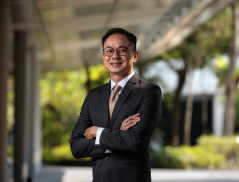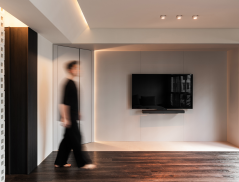
In Singapore to check up on their latest project, Joel Wong and Amanda Gunawan, Principals and Founders of design firm OWIU (an abbreviation for “Only Way Is Up”), also took time to meet up with us to share their thoughts on living and working here and in Los Angeles (LA), where they are based.
1. Why did you decide to pursue your architecture degree overseas versus doing so in Singapore, where you were raised?
Singapore is such a safe and familiar environment for us and we wanted to be out of our comfort zones to push ourselves as aspiring architects. There tends to be a systematic way in which the education system works in Singapore and it was solid, yes, but it was not new to us and we wanted change.
We wanted to expose ourselves to a different architectural climate to learn new ways of thinking, seeing and in turn, designing. The ability to design is a sensibility that is developed over time (and will continue developing as we go forward). It must be cultivated and cannot be learnt, the easiest way for that to happen was to put ourselves in a circumstance that is foreign.
2. How do you think your education at the Southern California Institute of Architecture (SCI-Arc) has benefited you as an architect?
SCI-Arc taught us how to create a process in design and how to link that back to architecture and the built environment. Through that, and a cultivation of our creativity and expansion of our minds, by offering liberal arts classes that eventually link back to architecture (such as a class on the punk rock movement), SCI-Arc aided in the development of the philosophy we have for OWIU.
SCI-Arc taught us how to form opinions, to evaluate all angles, but to eventually take a side and that our voice regarding that opinion mattered. We became more decisive in terms of design decisions, more sure of ourselves architecturally and capable of standing by the things we believe in, not by rejecting other people’s opinions, but by maintaining a fluidity in which you allow the idea to foster and progress.
3. If you were to contrast the architecture scene in LA, where you studied, live and work, against Singapore's, what are the three biggest differences?
In Singapore, minimum wage is significantly less because of the presence of foreign workers. In LA, labour is not only expensive, minimum wage labour is slipshod and unreliable. People are willing to do a lot less for a lot more and it therefore cultivates a more hands-on experience through the process of building. You definitely end up learning a lot more because you wear multiple hats all the time but efficiency also goes down quite a bit and the time that it takes to complete a project becomes a lot longer.
In architecture school in LA, your rhetoric is a pre-requisite to thriving in your architectural education. In Singapore, it is enough to simply walk the walk but in LA, you have to talk the talk as well. This means that your argument, theory and intent has to be solid and minimal in loopholes. A good project without a good narrative could never advance to become a great one.
Singapore’s architecture scene, at least in the residential sector, has become a little too cookie-cutter. LA’s architectural scene, although messy, is vibrant. Its lack of identity leaves room for multiple possibilities. Too much control in the creative process of architecture as a result of the lack of trust in architects can limit the unpredictability that might result in an interesting outcome. There are efforts that have certainly proved an openness to more radical schemes, such as the recent Founder's Memorial at Marina Bay competition proposals. We hope to see more competitions such as these, as we believe that testing new ideas will open up doors for introducing novel and smart ideas to new ways of living in our built environment.
4. Having worked in Singapore and LA, what are two important best practices that you can share?
It is important not to lose sight of what your original vision is, for the body of your work. It is so easy to do so because architecture as a profession can be so draining, both physically and mentally. And you are so challenged every day that it is easy to get complacent and simply do the tasks presented to you, but we can’t stress enough how important it is to still cultivate your creative side.
We do this by participating in more creative and conceptual competitions, research on topics that are not necessarily directly related to what we are working on but will reveal a tangent eventually, having design charettes every so often and taking on jobs that do not necessarily pay the most, but give us the creative liberty to do what we want, research a new technique and prove a point.
With this said, it brings us to our second most important best practice, which is to keep your team motivated. Train your team to be able to take on leadership roles that were previously yours, teach them all your best kept secrets and skills and get rid of hierarchies. Everyone is a team captain and with that, everyone’s stake will be just as large as one another’s. We no longer have to justify why we would need to work a little extra this week, they already know it and want to. In architecture, it is a lot more productive to have a team of five competent, jack of all trades than 10 people who can only do one thing and follow instructions from you because an architect always has to do so many things.
5. As a member of Gen Z, what do you think is the biggest threat to architecture at the moment?
The biggest threat could potentially be a lack of thought and intention in design. We are at a time when everything is so speed-centric and efficiency is a triumphant element. Don’t get us wrong, we are not discrediting any of those things. They are important, but what happens is that because information is so easily accessible and therefore exchanged, a design process no longer requires the same amount of rigour and as a result, thought. In the old days, what would have taken years to research – a skill or craft that would have taken years to hone – now takes a much shorter time because the knowledge is so readily available. This is great but as a result, there inevitably is a lack of thoughtfulness and intention in the design process, which is why we often see buildings with designs that are good but not great.
There is understandably a necessary emphasis on efficiency that needs to take place in the real estate industry in Singapore. We are one of the forerunners in economic progress in Asia and the quick turnover of real estate developments is a huge contributor to this success. A change in focus to one that nails the “sweet spot” melding both efficiency and craftsmanship can be introduced into these projects that could, in the long-run, provide a value surpassing simply quick turnovers in profits. A bit more “soul” can go a long way producing distinguishable icons or landmarks spread across the whole country.
One country that has done a remarkable job at creating efficient yet interesting and smart housing is Denmark. Copenhagen is a prime example of a city whose architecture blends both innovation as well as efficiency in urban planning, and has managed to therefore test the boundaries of typical residential housing. Singapore definitely has the appropriate conditions as well as resources to be able to follow suit.
Read more about OWIU’s latest project in Singapore in d+a's Issue 115 (April/May2020), available for sale on Magzter and in major bookstores in Singapore and Malaysia.


 Share
Share









